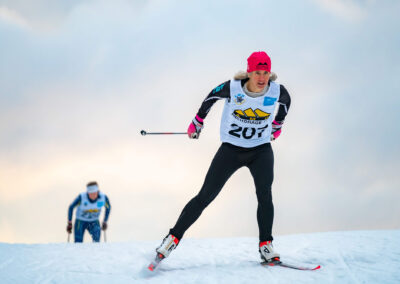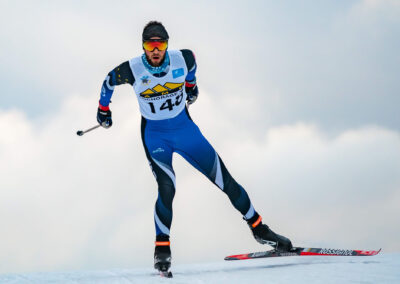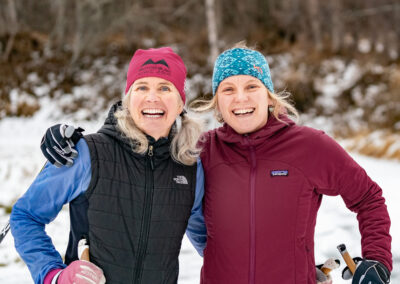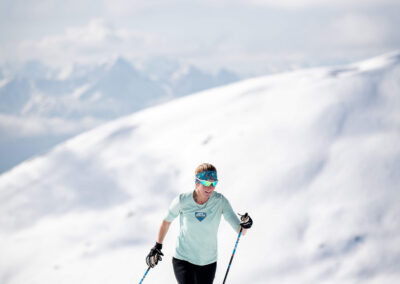Masters Program
The APU Master Program is a community based cross-country ski program that offers group-training sessions for adults. The goal of the program is to help develop cross-country ski skills, improve fitness, and promote skiing in the community.
If you are skiing for fitness, just getting started or a seasoned racer, the APU Master program offers great training and a lot of fun!
The group training focus is on technique and ski fitness. Summer training includes roller skiing, running, ski imitation, biking, and strength. Sessions are designed to fit the training group. In the winter ski sessions alternate between classic and skate. Strength training is an important component in Master training. One strength session is scheduled every week in all seasons.
One of the best parts of the Master program is that it provides a group to ski and train with year round. It is a great environment to learn about technique, waxing, and training. As a part of the Master program, you can take part in wax clinics, community races, spring crust skis, and club ski-selection nights at local retailers. Race support offered for Anchorage Cup and local Marathon races.
Training is typically located at Hillside, APU, and Kincaid. Athletes will also take special training sessions to run in the mountains or ski other trails.
Head Coach: Galen Johnston
Assistant Coaches: Eliza Rorabaugh
There are three options: Noon Masters, Evening Masters, and a Flex Option.
- Noon Masters meet from 12:15 to 1:45 PM
- Evening Masters meet from 6:30 pm to 8:00 pm
- Flex Option, you have the option to attend the Noon or Evening Masters as it best fits your schedule.
All groups are coed. Sessions are scheduled Monday, Wednesday, and Thursday.
Summer (April 29, 2024 to August 29, 2024)
Noon or Evening …… $880
Flex ………………….. $980
Fall (September 9, 2024 to October 24, 2024)
Noon or Evening …… $450
Flex ………………….. $470
Winter (October 28, 2024 to April 3, 2025)
Noon or Evening …… $1400
Flex ………………….. $1610
Year Round (April 29, 2024 to April 3, 2025)
Noon or Evening …… $1970
Flex ………………….. $2210
- APU (map link) – Meet on the lawn in front of Atwood Center.
- Hilltop Ski Area (map link) – Meet at the far end of the inner parking area at the Nordic Ski Trailhead.
- Kincaid Park (map link) – Dryland Activity: Meet at the ‘soccer ball’ patio along the paved path near the chalet. On Snow: Meet on the north side of the lower parking lot.
- Glen Alps (map link) – Meet at the main trailhead.
- Prospect Heights (map link) – Meet at the main trailhead.
- Upper Huffman (map link) – Meet at the main trailhead.
- Rabbit Lake Trailhead (map link) – Meet at the main trailhead.
Dryland (Summer/Fall/Early Winter)
- Running Shoes – Must be suitable for mountain running and muddy trails
- Bike Helmet
- Skate Roller Skis – Roller ski selection is based on both skill level and what ski boots you use. Beginner/Intermediate skiers will enjoy the added stability of the wider wheel of the Ski Skett Fire, Fischer RC5 skate, or similar. More advanced skiers will prefer a larger wheel diameter (narrower width) ski like the Swenor Alu Skate, Fischer RC7 Skate, or similar, which allow for a more natural ski feel. Skiers who are in entry level skate boots, or soft combi boots that lack good torsional stability may find this style ski difficult to ski on. It’s always a good idea to rent skis from AMH to try them out before you purchase any model.
- Skate Ski Boots -This can be a combi style boot, but needs to offer enough ankle stability to avoid rolling in off of the ski. Make sure to pair an appropriate ski with the boot you have.
- Skate Roller Ski Poles – Skate poles should be roughly between chin and nose while standing in ski boots. For summer you need to swap the basket out for a ferrule that is more durable on pavement. AMH can take care of this for you!
- Classic Roller Skis – There are many classic skis available on the market. Aluminum shaft skis offer good stability, but transmit more vibration into the feet. Composite shaft skis offer a more realistic ski feel, and less vibration transmission, but are often less stable feeling to newer skiers. It’s always a good idea to rent skis from AMH to try them out before you purchase any model.
- Classic Ski Boots -This can be a combi style boot, but should allow you to roll through the ball of the foot in a striding motion.
- Classic Roller Ski Poles – Classic poles should be cut to 83% of body height measured in ski boots. This measurement is the maximum height at which the strap can exit the pole. For some this is longer than ideal but it is a good starting point. You can always cut them down! For summer you need to swap the basket out for a ferrule that is more durable on pavement. AMH can take care of this for you!
- Classic or “Bounding” poles – For days that we run and bound with poles. Your winter classic poles will work just fine, though if you have something a little shorter (fit in the armpit) that is ideal.
- Mountain Bike – Good tire tread and mechanically sound. Riders need to be able to shift gears easily. Brakes should be in good working order.
- Drink Belt or Hydration Pack – For Mountain Run days it’s good to have a little water, a snack, and a way to carry a rain/wind jacket.
On Snow (Winter)
- Running Shoes – Studded shoes or removable ice cleats recommended
- Ski Boots – Combi boots work initially and are a great way to save cost. Designated skate and Classic boots help skiers develop good ski feel and balance. Eventually this is a good investment to make.
- Rock/Training Skis (Skate and Classic) – A separate pair of skis for both Skate and Classic techniques is ideal though not required. These are skis that are used when damage to the ski is likely to occur. Early season skiing, adventure skis, and game days are good times to utilize these skis. These skis also can function as warm-up skis before races when coaches are waxing race skis.
- Race Skis (Skate and Classic – A separate pair of skis for both Skate and Classic techniques.
- Skate Poles – Length should be between lower lip and nose.
- Classic Poles – Length to top of strap attachment should be 83% of body height standing in classic ski boots, or shorter.
Wax
- Classic Kick Wax – Lots of companies to choose from. Pick a basic line from one company and get to know it. One of each of the below waxes will cover most conditions.
- Cork – Synthetic Corks work most efficiently
- Binder – optional. Ironed onto bare base to increase kick and durability of kick wax layers.
- Blue – Swix V40, Toko Blue, Start Blue are all good options
- Violet – Swix V45 or V50, Start Purple, Toko Red
- Red – Swix V60, Toko Yellow, Start Red or Yellow
- Klister – Swix KX40S, Swix Silver Universal (can applicator is super easy)
- Glide Wax – Waxing skis regularly allows for skis to be faster and last longer. Feel free to ask for guidance. Below are two options.
- Hot wax – Wax applied with iron. Best durability but more investment. Requires: Waxing form, Waxing Iron, Wax (A “Green”, a “Blue” and a “Red” wax are good places to start), Glide Scraper, Groove scraper, Metal Brush (Copper or Steel), Nylon/Horsehair Brush
- Liquid glide wax – Wax applied from bottle, usually with sponge applicator. Less durable, but easier to apply. Requires less investment and is less likely to damage skis. Best applied after skiing and then brushed out prior to next ski. Requires: Wax, Brush (combi metal/nylon works well)
Clothing
- Hat – Something to keep your ears warm and your head covered.
- Gloves – Low profile but warm is ideal.
- Mittens – If your hands ever get cold check out Nordic specific mittens. They are thin, so they fit in ski pole straps, but also very warm!
- Buff – Or other face/neck cover. Just wearing this around your throat warms the air going into your lungs. Optional – Cold air Mask – Airtrim makes a good mask that allows air to be warmed and moisturized as it comes into your lungs. If you have trouble breathing in the cold, or simply want to look out for your lungs, this is a good thing to have in the kit! They’re great for warming up for cold races.
- Jacket – Something that you can move in that isn’t overly bulky, but will keep you warm. Ideally an outer material that snow doesn’t stick to too badly.
- Pants – Not overly bulky, but warm. Ideally an outer material that snow doesn’t stick to too badly.
- Long Underwear – Top and Bottom. Something other than cotton!
- Race suit – Optional. Spandex to race/train in. Wind Briefs – If you’re wearing a spandex suit and you’re a boy you need these. You will regret it if you don’t wear them.
- Drink Belt or water bottle carrier – Optional. If you like a little water on the ski this is a good investment.
- Boot Covers
- Anchorage Cup Races organized by NSAA
- Race to the Outhouse by Mat-Su Ski Club
- Tour of Anchorage by NSAA
- Oosik Classic by Denali Nordic
- Homer Ski Marathon by Kachemak Nordic
- Sonot Kkazzoot by Fairbanks Nordic Ski Club
- Alyeska Hill Climb by CCAK and Girdwood Nordic
- Basic Fitness/Skill – We welcome all ability levels but some prior ski skill is encouraged. Those considering joining should be able to safely navigate beginner level trails of the Anchorage trail systems. Masters should be able to run/walk or ski for 15-30 minutes without stopping and be able to move for over 90 minutes with short breaks.
- Health – Participants must be healthy to participate in practice. Stay home and take rest when you’re sick. Communicate with the Coach any existing injuries or health concerns that may be affected by participating in our practice activities.
- Readiness – Participants are expected to arrive in time to receive important instructions given at the beginning of each practice, and with appropriate gear.
- Registration Payments and Waivers – All registration is online and required before attending the first session.
- Family Discount – After purchasing two year round memberships, all additional memberships are half price. Please contact coaches to get a registration coupon.
- Payment Plans are available for year round memberships. The payment can be split into two payments, the first half is due before the first day of practice and the second half due October 1. To enroll, choose the year round payment plan option when registering.
- Helmets are required at all roller ski and bike sessions.
REGISTER ONLINE NOW
One-Week Trial Membership
If you want to check out the program before signing up, we offer a one-week trial membership for new members.
One Week Trial Registration »




